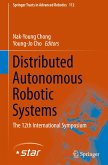It is man's ongoing hope that a machine could somehow adapt to its environment by reorganizing itself. This is what the notion of self-organizing robots is based on. The theme of this book is to examine the feasibility of creating such robots within the limitations of current mechanical engineering. The topics comprise the following aspects of such a pursuit: the philosophy of design of self-organizing mechanical systems; self-organization in biological systems; the history of self-organizing mechanical systems; a case study of a self-assembling/self-repairing system as an autonomous distributed system; a self-organizing robot that can create its own shape and robotic motion; implementation and instrumentation of self-organizing robots; and the future of self-organizing robots. All topics are illustrated with many up-to-date examples, including those from the authors' own work. The book does not require advanced knowledge of mathematics to be understood, and will be of great benefitto students in the robotics discipline, including in the areas of mechanics, control, electronics, and computer science. It is also an important source for researchers who wish to investigate the field of robotics or who have an interest in the application of self-organizing phenomena.








